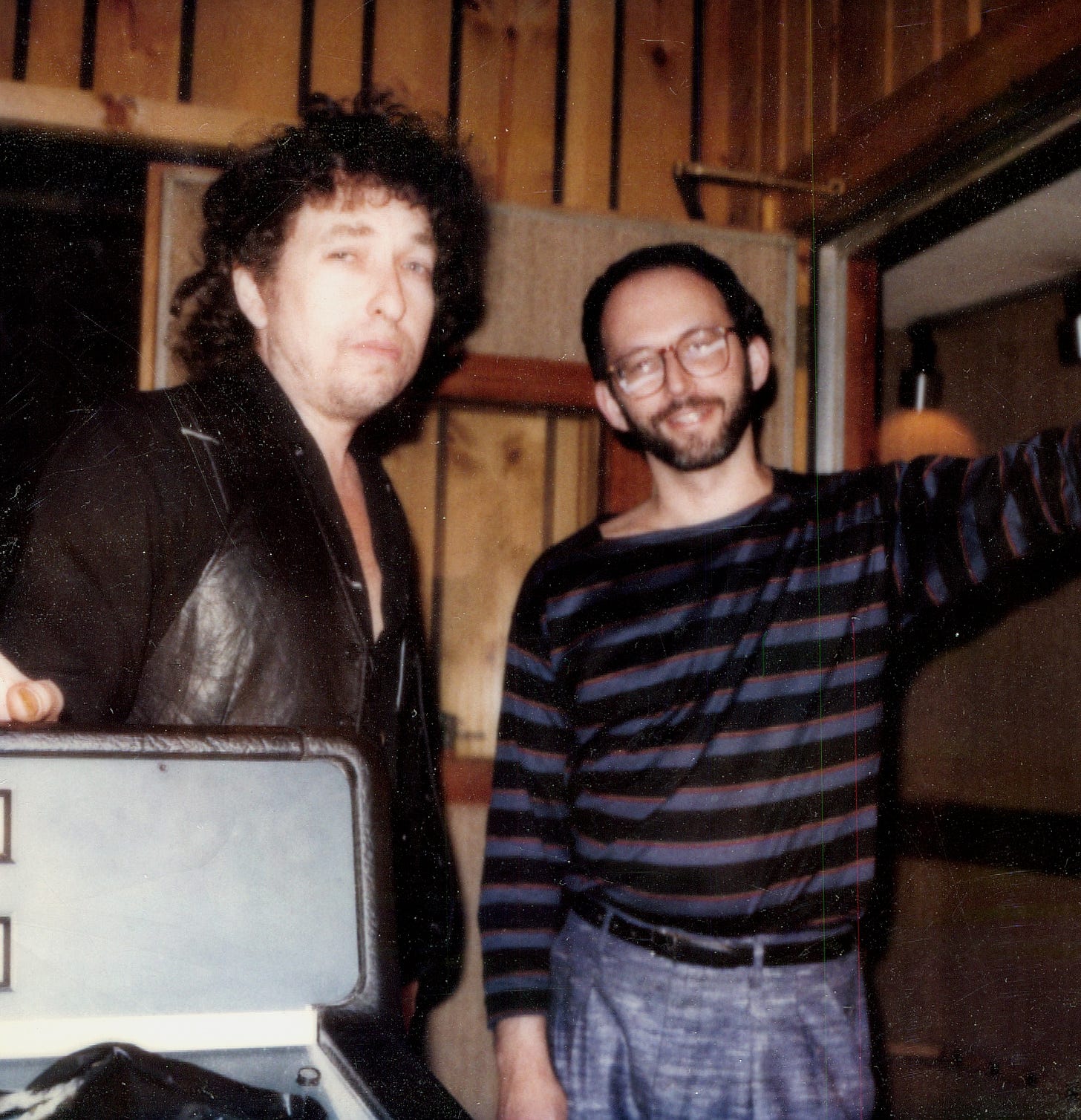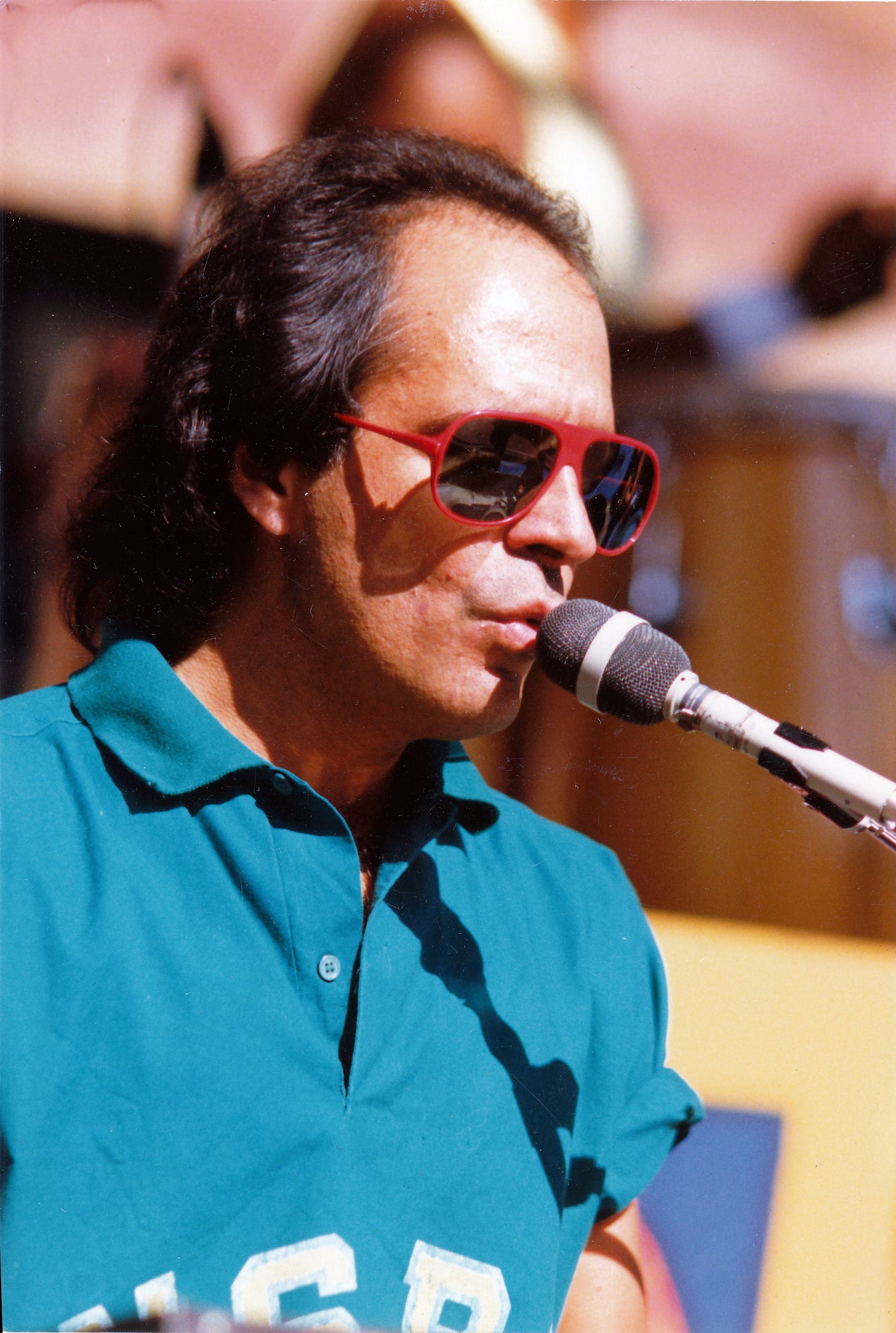The Synthesizerin' Bob Dylan
The Empire Burlesque Interviews #4&5: Vince Melamed & Richard Scher
Flagging Down the Double E’s is an email newsletter exploring Bob Dylan concerts throughout history. Some installments are free, some are for paid subscribers only. Sign up here:
As far as I can figure out, Empire Burlesque was the first time synthesizer was played on a Bob Dylan record. And that oil-and-water-seeming mix describes a big part of the reason the album was so controversial. Synthesizer? On a Bob Dylan record???
So, for the fourth part in our weeklong interview series, I spoke to two of the synth players on Empire Burlesque. Though they played the same instrument (instruments plural, really, as several different keyboards and synths were employed), they ended up on the album in two very different ways.
The first, Vince Melamed, was brought in by bandleader Ira Ingber for the early sessions out in LA, playing live in the studio with Bob and the band. He appears on “Something’s Burning Baby” as well as a number of songs left on the cutting room floor that resurfaced later (most notably “Brownsville Girl”).
The second, Richard Scher, was brought in by mixer Arthur Baker to overdub synth parts in New York when the record was already nearly finished, to make it sound more contemporary. He appears on five tracks on Empire Burlesque, quite prominently on a song like “When the Night Comes Falling from the Sky.”
Vince Melamed—Early LA Sessions
How did you get brought in?
I had just gotten off the road with Jimmy Buffett. I knew Ira [Ingber], and I got a call from him. He said, “Hey, you wanna come to Bob Dylan’s house and rehearse? We’re not sure if it’s going to go anywhere past that.” I said, “Sure!”
So I talked to the road manager. He said, “What do you need?” I said, “Hammond B3 and I’ll bring my own [synthesizers], probably a Prophet 5 and a DX7.” And that was it.
Take me through day one of the rehearsals. What do you remember?
Okay, so you go to his house. There’s a guest area, which is like his music room or something. We get there, let’s say, at 12. Of course, we don’t see him until 2. So we’re just hanging out. This would have been me and Ira and Carl Sealove [bass] and Don Heffington on drums.
Then finally he comes in. Walks in, kind of scratches his head, picks up a guitar, and just starts playing. Doesn’t say a word to us. So we start playing with him. After maybe 20 minutes of jamming, the first thing he ever said to us was, “Any of you guys ever been sued for plagiarism?”
We went, “Uh no, I don’t think so…” He goes, “I am. I wrote this song called ‘Blowin’ in the Wind…’” I felt like going, “Oh, really, Bob? How does it go? I’ve never heard it.” [laughs]
That was the first words he ever spoke to us.
Are you familiar with Cyrano de Bergerac? It was a famous play like 300 years ago. He was a guy with a big, long nose that went out further than Pinocchio’s. And if anyone was looking at his nose, he would start, “Do you notice my nose? Is it offensive?” You know, like Dylan does in Dont Look Back, where he’d go off on a five-minute tirade. So, in the beginning, I was very, very shy. Because he would say something like that to Ira: “Did you like that last take?” And Ira would go, “yeah.” He’d go, “I didn’t like it.”
Like a trap.
Yeah. Contradictory. He’s a contrarian, he’s just playing, but you never know if he is or not. That was an intimidation for me.
So what are you playing? Are they songs? Are they covers? Are they instrumentals?
The very first thing, when he came in two hours late, I think it was just a jam. Then two, three hours in, he said, “Okay, suppose this is a song…” He starts playing and we just go along with it. You have to think fast and in some ways that’s good.
That was for three weeks. He’d always say, “Can you come back tomorrow?” But we already knew what the schedule was, which days were going to be on and off, so we’d go, “Sure, Bob, I can make it.”
Three weeks is a long time. How did it evolve?
We got more comfortable. He talked to Ira, because Ira is also from Minnesota originally. He’d go, “Hey, Ira, ever hear of the so-and-so club?”
Then we didn’t hear from him. We figured, “Okay, I guess he’s moved on to something else.” Then we got a call to show up at Cherokee, and that’s when we started doing the sessions.
At this point, after three weeks of rehearsals, do you have a sense of what you’re going to record in the studio?
No. Of course, since I knew most albums up to Infidels—and I’m a big Blonde on Blonde fan—I kind of knew what keyboard and expected that kind of playing. I brought my Prophet synthesizer. “Something’s Burning,” that’s a Prophet, as well as organ.
I was in Bobby Womack’s band for two years. I was a bandleader there, and I learned, in R&B, how to listen to other players. How it’s not the notes you play but what you don’t play. And all those guys in the room at that time were professionals. So we just learned to listen to each other, not to get in each other’s way, and most of all watch the boss.
So you get the call, you go to sessions at Cherokee, what happens next?
Bob shows up. We played the song that he wrote with Sam Shepard. Originally it was called “Danville Girl.” Then they had to change it to “Brownsville Girl” because there was another “Danville Girl” song. That “New Danville Girl” that you hear on Springtime in New York is the same take just without all the bullshit. I can finally hear myself.
I really like Empire Burlesque, but it has come into a fair amount of criticism for exactly what you’re talking about— Are you an Empire Burlesque skeptic yourself? You just made a noise when I said I liked it.
I hated the sound. It was so ’80s. We used to call it “cocaine mixes.” You know, “I can’t hear the highs,” boosting ‘em up. It’s a very harsh ’80s-sounding album.
Listen, he was a trip. There’s a synthesizer company, Roland. In the very early days, they had these little tiny drum machines, and they also had a thing called a synth bass. It was kind of like this long box, and you had buttons to do the 12-tone scale. He came in with the Roland and said, “I got this bass machine!”
Keep reading with a 7-day free trial
Subscribe to Flagging Down the Double E's to keep reading this post and get 7 days of free access to the full post archives.


